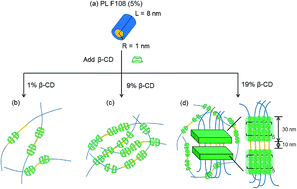Fine structures of self-assembled beta-cyclodextrin/Pluronic in dilute and dense systems: a small angle X-ray scattering study
Abstract
The evolution of the fine structures of self-assembled polypseudorotaxane (PPR) in Pluronic (PL F108) solutions containing dilute to dense beta-cyclodextrin (β-CD) was illustrated for the first time by small angle X-ray scattering (SAXS). Dense β-CD (∼19 w/v%) was found feasible to be dispersed in 24% citric acid solution. 5% of PL F108 formed cylindrical micelles of 1 nm in radius and 8 nm in length in the presence of 24% citric acid through the dehydration of citric acid and citrate. PPR was formed through host–guest interaction between PL F108 and β-CD. In dilute β-CD system (1%), the single chains of PPR with separated β-CD stacks on PL F108 were formed. The numbers of β-CD in each stack increased from 1 to 4 on increasing β-CD concentration to 9%. In a dense β-CD system, PPR condensed to correlated structures majorly composed of two unit blocks through the hydrogen bonds between PPRs. Two distinguishable correlated domains with correlation lengths of 50 nm (marked α-phase) and 46 nm (marked β-phase) along the chains, but without fine periodic structure within each individual domain, were identified in the 10% β-CD solution. Periodic stacking of β-CD in the domains developed in the 12% solution. As β-CD concentration increased from 12 to 19%, the correlated heights of α and β phases reduced from 41 and 32 nm to 30 and 10 nm, respectively. There were 48 β-CDs that stabilized on each PL F108 chain in the 19% β-CD system, which is in good agreement with stoichiometry.


 Please wait while we load your content...
Please wait while we load your content...